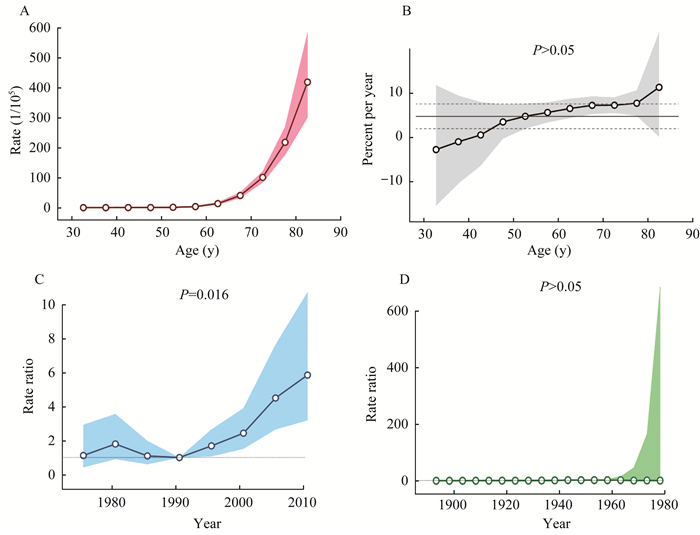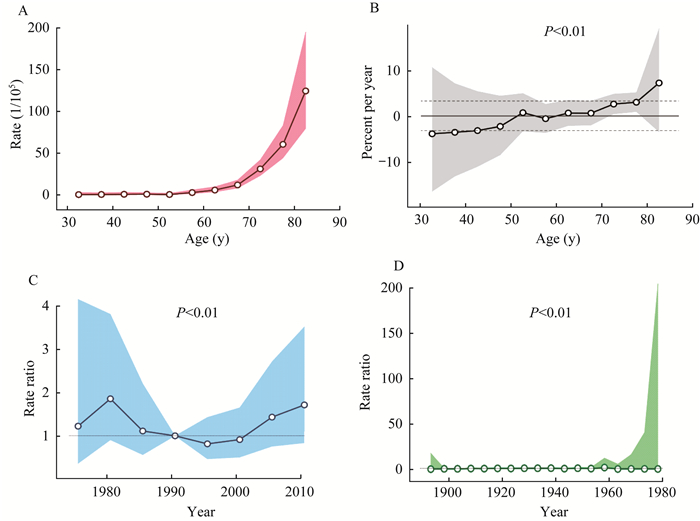2. 上海市长宁区疾病预防控制中心 上海 200051
2. Shanghai Changning District Center for Disease Control and Prevention, Shanghai 200051, China
前列腺癌是世界上最常见的男性恶性肿瘤之一,2018年全球发病例数占所有男性恶性肿瘤的13.5%,仅次于肺癌[1]。发达国家的发病率高于发展中国家,发病率最高的国家或地区是澳大利亚和新西兰(86.4/10万)、北欧(85.7/10万)、西欧(75.8/10万)、北美洲(73.7/10万),最低的是南亚(5.0/10万)、东南亚(12.7/10万)、北非(13.2/10万)和东亚(13.9/10万)[1]。过去我国前列腺的发病率远低于欧美国家,但近年来呈加速上升趋势。全国的数据显示,1998年的发病率为2.88/10万,2008年则为6.73/10万,且城市的发病率(7.66/10万)高于农村(2.56/10万)[2]。上海市的数据显示,1998年的发病率为5.8/10万[3],2008年则升至11.80/10万[4]。全面了解和分析前列腺癌的发病与死亡变化趋势,是前列腺癌防控的基础工作之一。
本文根据上海市长宁区1973—2013年的肿瘤登记数据和死亡统计资料,分析该区男性居民的前列腺癌发病与死亡情况,以了解该地区前列腺癌的长期变化趋势,为卫生行政部门制定前列腺癌的防控措施提供参考信息。
资料和方法病例资料 前列腺癌的发病数据来自于上海市肿瘤登记处收集整理的1973—2013年间的登记资料。上海市的肿瘤登记资料是一个以全人群为基础的肿瘤登记报告系统,包括恶性肿瘤新病例、肿瘤死亡病例和病例生存资料的收集,于1963年开始由上海市肿瘤研究所的预防统计研究室(后更名为肿瘤流行病学研究室)负责全市肿瘤登记的日常工作(1966—1971年间有中断)。2002年开始至今,肿瘤登记处转移至上海市疾病预防控制中心[5]。上海市肿瘤登记处执行的技术规范参照国际癌症研究中心(IARC)和国际癌症登记协会(IACR)定期发布的标准和指南,以及全国和上海市颁布的标准和指南等[6-7]。前列腺癌的死亡数据均由上海市疾病预防控制中心收集与整理。
人口资料 由上海市长宁区公安局定期发布的人口数据,并根据1973、1979、1982、1985、1990、1992、1996、2000和2010年全国或上海市9次人口普查获得的性别和各年龄组的人口资料,用内插法和外推法估算得出各年龄组数据。
统计学分析 将诊断年份按5年一组分成1973—1977、1978—1982、1983—1987、1988—1992、1993—1997、1998—2002、2003—2007、2008—2013(该组6年)共8个时期,分别计算出各时期的前列腺癌粗发病率和粗死亡率、基于2000年中国人口年龄构成的标化率(ASR China)、基于2000年Segi世界人口年龄构成的标化率(ASR World),以及0~74岁的累积发病率和累积死亡率(cumulative rate)。
用Joinpoint软件[8]对世标率进行1973—2013年发病率与死亡率的趋势分析。本研究以5年为一段时期的结点,计算年度变化百分比(annual percent change,APC)和平均年度变化百分比(average annual percent change,AAPC)。APC > 0表示该时期呈上升趋势,APC < 0表示该时期呈下降趋势,结点的变化是否有统计学意义采用95%渐近线排列检验[9]。
用年龄-时期-队列(age-period-cohort)模型进一步分析年龄因素、诊断时期因素和出生队列因素对发病率和死亡率的影响。采用美国国立癌症研究所(NCI)提供的网页分析工具[10],分别计算了:(1)从30~84岁(按5年一组)各年龄别的发病率和死亡率,即纵向年龄曲线;(2)各年龄别发病率和死亡率的APC,即局部漂移值;(3)调整了年龄和出生队列后的时期率比,即各诊断时期对发病和死亡的危险比,根据惯例以中间时期组(1988—1992年)为参照组;(4)调整了年龄和诊断时期后的队列率比,即出生队列对发病和死亡的危险比,按惯例以中间队列(1931—1935年)为参照组。上述参数的假设检验采用Wald χ2检验。
结果1973—2013年长宁区前列腺癌的发病与死亡情况 1973—1977年长宁区前列腺癌的粗发病率为0.69/10万,世标发病率为0.85/10万。之后持续上升(除1978—1982年外),2008—2013年粗发病率升至40.06/10万,世标发病率至19.00/10万;0~74岁的累积发病率也从0.16%升至1.82%(表 1)。前列腺癌的粗死亡率从1973—1977年的0.46/10万升至2008—2013年的16.24/10万,而粗死亡/发病比则从66.7%降至40.5%;世标死亡率从0.78/10万升至6.82/10万,世标死亡/发病比从91.8%降至35.9%;累积死亡率从0.07%升至0.31%(表 2)。不同时期各年龄别的发病率和死亡率见表 3和表 4。
| Years | New cases | Crude incidence (1/105) | ASRa (1/105) | ASRb (1/105) | CR/% (0-74 years) |
| 1973-1977 | 6 | 0.69 | 0.78 | 0.85 | 0.16 |
| 1978-1982 | 18 | 1.92 | 2.23 | 2.79 | 0.22 |
| 1983-1987 | 20 | 1.66 | 1.67 | 1.87 | 0.20 |
| 1988-1992 | 29 | 2.05 | 1.85 | 2.20 | 0.22 |
| 1993-1997 | 80 | 5.22 | 3.67 | 4.52 | 0.37 |
| 1998-2002 | 167 | 10.90 | 5.82 | 7.28 | 0.55 |
| 2003-2007 | 369 | 23.78 | 11.32 | 13.50 | 1.31 |
| 2008-2013 | 740 | 40.06 | 16.07 | 19.00 | 1.82 |
| Total | 1429 | 13.12 | 10.12 | 12.38 | 0.98 |
| aAge adjusted by the China standard population; bAge adjusted by the world population.ASR:Age standardized rate; CR:Cumulative rate. | |||||
| Years | No. of deaths | Crude mortality (1/105) | ASRa (1/105) | ASRb (1/105) | CR/% (0-74 years) |
| 1973-1977 | 4 | 0.46 | 0.69 | 0.78 | 0.07 |
| 1978-1982 | 16 | 1.70 | 1.76 | 2.03 | 0.25 |
| 1983-1987 | 19 | 1.58 | 2.05 | 2.87 | 0.14 |
| 1988-1992 | 27 | 1.91 | 1.89 | 2.42 | 0.13 |
| 1993-1997 | 39 | 2.54 | 1.84 | 2.29 | 0.15 |
| 1998-2002 | 72 | 4.70 | 2.50 | 3.43 | 0.16 |
| 2003-2007 | 129 | 8.31 | 3.64 | 4.65 | 0.34 |
| 2008-2013 | 300 | 16.24 | 4.96 | 6.82 | 0.31 |
| Total | 606 | 5.56 | 4.21 | 5.74 | 0.27 |
| aAge adjusted by the China standard population; b Age adjusted by the world population. | |||||
| Years | Age (y) | ||||||||
| < 50 | 50-54 | 55-59 | 60-64 | 65-69 | 70-74 | 75-79 | 80-84 | ≥85 | |
| 1973-1977 | 0.00 | 0.00 | 2.39 | 3.27 | 4.57 | 21.88 | 0.00 | 0.00 | 0.00 |
| 1978-1982 | 0.14 | 1.42 | 1.90 | 10.61 | 0.00 | 27.95 | 32.10 | 53.53 | 96.34 |
| 1983-1987 | 0.11 | 0.00 | 1.34 | 3.69 | 16.22 | 16.55 | 36.41 | 17.16 | 0.00 |
| 1988-1992 | 0.00 | 1.16 | 3.35 | 2.77 | 6.05 | 31.27 | 33.06 | 36.23 | 31.06 |
| 1993-1997 | 0.09 | 0.00 | 5.00 | 12.20 | 11.17 | 44.62 | 60.91 | 99.84 | 99.92 |
| 1998-2002 | 0.00 | 1.74 | 1.38 | 15.11 | 34.20 | 58.17 | 98.78 | 167.07 | 211.35 |
| 2003-2007 | 0.00 | 3.02 | 8.57 | 39.12 | 83.11 | 127.35 | 179.43 | 252.02 | 207.42 |
| 2008-2013 | 0.19 | 3.41 | 10.85 | 39.59 | 128.28 | 181.19 | 289.40 | 353.71 | 234.83 |
| Total | 0.07 | 1.86 | 5.78 | 19.59 | 46.21 | 86.28 | 156.21 | 226.33 | 190.31 |
| Years | Age (y) | ||||||||
| < 50 | 50-54 | 55-59 | 60-64 | 65-69 | 70-74 | 75-79 | 80-84 | ≥85 | |
| 1973-1977 | 0.00 | 0.00 | 0.00 | 0.00 | 0.00 | 14.59 | 30.52 | 0.00 | 0.00 |
| 1978-1982 | 0.14 | 0.00 | 3.81 | 10.61 | 0.00 | 33.55 | 10.70 | 53.53 | 0.00 |
| 1983-1987 | 0.11 | 0.00 | 0.00 | 0.00 | 13.51 | 12.41 | 21.85 | 51.49 | 218.34 |
| 1988-1992 | 0.09 | 0.00 | 1.12 | 2.77 | 2.02 | 18.76 | 38.57 | 84.54 | 62.11 |
| 1993-1997 | 0.18 | 0.00 | 1.25 | 3.33 | 8.38 | 14.87 | 38.07 | 46.08 | 66.61 |
| 1998-2002 | 0.00 | 0.00 | 0.00 | 4.53 | 8.55 | 19.90 | 46.79 | 59.28 | 222.47 |
| 2003-2007 | 0.00 | 0.00 | 3.81 | 6.02 | 16.62 | 41.98 | 63.67 | 90.28 | 177.79 |
| 2008-2013 | 0.00 | 0.97 | 2.58 | 6.99 | 7.55 | 44.15 | 79.31 | 186.39 | 387.65 |
| Total | 0.07 | 0.23 | 1.83 | 4.58 | 8.17 | 28.46 | 55.46 | 112.37 | 254.83 |
1973—2013年长宁区前列腺癌的发病与死亡趋势 Joinpoint趋势分析结果显示,前列腺癌的发病率与死亡率均呈上升趋势。1973—2013年前列腺癌发病率的年度变化百分比(APC)和年均变化百分比(AAPC)均为8.78%,变化趋势有统计学意义(P < 0.05)。死亡率的AAPC为4.64%,有统计学意义(P < 0.05);APC在1973—1997年为1.23%(P > 0.05),1998—2013年为7.11%(P < 0.05,表 5)。
| Prostate cancer | AAPC (%) | Period 1 | Period 2 | |||
| Years | APC (%) | Years | APC(%) | |||
| Incidence (ASR World) | 8.78(1) | 1973-2013 | 8.78(1) | |||
| Mortality (ASR World) | 4.64(1) | 1973-1997 | 1.23 | 1998-2013 | 7.11(1) | |
| (1)P < 0.05. | ||||||
前列腺癌发病和死亡的年龄-时期-队列模型分析 从年龄来看,前列腺癌的发病风险随年龄增长持续增大(图 1A)。局部漂移值(即各年龄别的APC)在30~34岁组为-2.76,50~54岁组升至4.7,80~84岁组的则升至11.8,经Wald检验差异有统计学意义(P < 0.01,图 1B)。从诊断时期来看,以中间组1988—1992年为参照组,发病危险比从1973—1977年的1.1升至2008—2013年的5.9,其中在1978—1982年有个小峰值(1.8,图 1C),从1988—1992年开始呈持续上升趋势。从出生队列来看,以1931—1935年的出生队列为参照组,最早出生队列的危险比为0.1,持续升至1941—1945年出生队列(1893—1897年)的2.3,至1961—1965年的出生队列,发病危险比稳定在2.1~2.3。经Wald检验,时期和队列效应均有统计学意义(P均 < 0.01,图 1D)。

|
| A:Longitudinal age curve; B:Local drifts with net drift; C:Period relative risk; D:Cohort relative risk. 图 1 前列腺癌发病率的年龄-时期-队列模型分析 Fig 1 Age-period-cohort analyses of the incidence of prostate cancer |
前列腺癌的死亡风险也随年龄持续上升(图 2A)。局部漂移值在30~34岁组为-3.79,升至80~84岁组的7.25,但经Wald检验差异无统计学意义(P > 0.05,图 2B)。从诊断时期来看,在1973-2002年间,除1978—1982年的死亡危险比有一个峰值(1.9)外,其他时期的死亡危险比基本稳定在0.8~1.2;但自2003年后死亡危险比开始迅速上升,至2008—2013年达1.7,Wald检验提示差异有统计学意义(P=0.016,图 2C)。从出生队列来看,各组死亡危险比无显著变化(P > 0.05,图 2D)。

|
| A:Longitudinal age curve; B:Local drifts with net drift; C:Period relative risk; D:Cohort relative risk. 图 2 前列腺癌死亡率的年龄-时期-队列模型分析 Fig 2 Age-period-cohort analyses of the mortality of prostate cancer |
本研究汇总了上海市长宁区自1973年开展肿瘤登记工作[5]以来41年的前列腺癌发病和死亡数据,时间跨度长,结果对准确了解列腺癌的发病率和死亡率的变化趋势有较重要的价值。尽管20世纪七八十年代前列腺癌的发病数和死亡数都较少,但从整体趋势上仍有助于全面了解和认识该病的流行病学特征。此外,本研究资料仅为上海市长宁区的肿瘤登记数据,可能不能反映上海市的全貌,是本次研究的局限性之一。
上海市长宁区前列腺癌的发病率趋势基本为持续上升,尤其自20世纪90年代末以后上升幅度越来越大。与全国肿瘤登记中心41个地区前列腺癌登记资料的比较显示,全国1998—2008年前列腺癌的发病率也呈明显上升趋势[2]。1998年全国前列腺癌粗发病率为3.52/10万,2008年升至11.00/10万,世标发病率从2.88/10万升至6.73/10万,上升幅度分别为212.5%和133.7%;同时期上海市的粗发病率从9.3/10万升至29.02/10万[3-4],世标率从5.8/10万升至11.80/10万[3-4],上升幅度分别为212.04%和103.45%;而同时期长宁区的粗发病率和世标发病率上升幅度分别为267.5%和161.0%。可见在1998—2008年期间,上海市前列腺癌发病率的上升幅度略小于全国水平,而长宁区的上升幅度则高于全国水平。
本研究显示长宁区前列腺癌的死亡率也呈上升趋势(1983—1987年有一个小的峰值,可能与1978—1982年发病率的小峰值有关),但上升幅度要小于发病率,死亡/发病比下降。这可能与早期病例的发现增加、多数早期病例的预后良好以及治疗手段的进步有关。国际上也有类似报导,一项研究(资料截至2012年)显示,近十年来大多数国家前列腺癌的发病率在上升、死亡率在下降,世界各国前列腺癌的发病率差异很大,但死亡率的差异却在缩小[11]。
从发病年龄来看,长宁区男性前列腺癌发病率随着年龄的增加而上升。韩苏军等[2]的报道显示50岁以上前列腺癌发病率随年龄的增加而进一步迅速升高。本研究中,各年龄别发病率的APC也持续上升(P < 0.05)。可见年龄因素与前列腺癌的发病密切相关,因此建议男性自50~54岁起,应加强对前列腺的体检监测。本研究中,各年龄别死亡率数据以及死亡率的纵向年龄曲线显示,前列腺癌的死亡率随着年龄增长而升高,但死亡率的APC经检验差异无统计学意义,这也与死亡率的上升幅度小于发病率上升幅度的结果一致。
从诊断时期效应看,发病危险比的持续上升是从1988—1992年开始的,至2008—2013年上升到约5.9倍。这体现了非致病因素(主要是诊断因素)对发病率的影响。前列腺癌是一种发展缓慢、病程长达10年以上的疾病。早期前列腺癌多无明显症状,或仅有类似良性前列腺增生的症状,如非专门检查,不易被发现。20世纪90年代初以来,以前列腺特异性抗原(prostate-specific antigen,PSA)为基础的筛检日益广泛地应用于临床,使前列腺癌的检出率比未用PSA之前提高了70%[12]。2000年以前,我国的健康体检未成规模,大多仅局限于入学、入职、出入境和婚检等;2000年后,随着经济的发展和生活水平的提高,许多个人和单位对健康体检的需求日益强烈,各类体检门诊、体检中心等迅速发展,体检人数逐年快速增加[13],大大增加了中早期前列腺癌的检出率。与发病危险比对照,本研究中死亡危险比的显著增加则晚了约10年,这与前列腺癌的病程时间基本相符。
从出生队列效应来看,以1941—1945年至1961—1965年这20年期间的出生队列危险比为高,且该20年出生队列的危险比也较稳定。与1941年之前的出生队列相比,应该是危险因素的暴露情况有所不同,并且这些危险因素在1961—1965年以后的出生队列中较为稳定。对前列腺癌危险因素的分析,至今尚无统一结论,目前主要集中在:年龄、地域、种族、遗传因素、雄激素、代谢综合征(高血压、高血脂、糖尿病)与肥胖、炎症与性传播疾病、射精频率、饮食等方面[14]。其中前5项因素不会随年代不同有大的改变;后4项因素中,多数研究认为代谢综合征与肥胖[15-19]、炎症与性传播疾病[20]是前列腺癌的危险因素。因此我们建议,为预防前列腺癌,应以减少上述因素的暴露为宜。射精频率因素与前列腺癌的关系目前尚有争议[21-22];饮食因素被认为与前列腺癌有关,但具体联系尚不清楚,一般建议减少肉类、奶类、高脂类的摄入[23-26],增加蔬菜、水果的摄入[14]。本研究中,各出生队列的死亡危险比无统计学差异,这部分解释了死亡率的上升幅度小于发病率的上升幅度,与国际上报导的多数地区前列腺癌发病率在上升、死亡率在下降的趋势大体一致[11, 26]。
综上所述,本研究显示上海市长宁区前列腺癌的发病率和死亡率均呈加速上升趋势,发病率的上升幅度大于死亡率,两者目前均未显示有拐点迹象。在今后的一段时期,对前列腺癌的防治将是本区甚至上海市肿瘤防治工作的重要内容之一。前列腺癌发病率的上升与年龄(老龄化)、诊断时期(早期诊断的增加)、出生队列(危险因素暴露的改变)都有关,为控制其发病率的上升速度,主要的工作还是加强对前列腺癌危险因素研究,在切实弄清危险因素的基础上减少其暴露,加强健康宣教。前列腺癌本身是预后相对较好的恶性肿瘤,现有的筛检手段也已较为成熟和可靠,充分利用现有的适宜技术做好高危人群的筛检工作,尽可能做到早期发现、早期诊治,有望进一步降低其疾病负担。
| [1] |
BRAY F, FERLAY J, SOERJOMATARAM I, et al. Global cancer statistics 2018:GLOBOCAN estimates of incidence and mortality worldwide for 36 cancers in 185 countries[J]. CA Cancer J Clin, 2018, 68(6): 394-424.
[DOI]
|
| [2] |
韩苏军, 张思维, 陈万青, 等. 中国前列腺癌发病现状和流行趋势分析[J]. 临床肿瘤学杂志, 2013, 18(4): 330-334. |
| [3] |
上海市肿瘤研究所流行病学研究室. 1998年上海市市区恶性肿瘤发病率[J]. 肿瘤, 2001, 21(4): 312. |
| [4] |
上海市肿瘤研究所流行病学研究室. 2008年上海市市区恶性肿瘤发病率[J]. 肿瘤, 2011, 31(10): 964. |
| [5] |
张薇, 鲍萍萍, 项永兵. 上海市肿瘤登记工作的历史、发展和现况[J]. 上海预防医学, 2019, 31(9): 717-723. |
| [6] |
全国肿瘤防治研究办公室. 中国肿瘤登记工作指导手册[M]. 北京: 中国协和医科大学出版社, 2004: 24-41.
|
| [7] |
吴凡, 卢伟, 李德録, 等. 上海市恶性肿瘤登记报告工作的调整与完善[J]. 中国肿瘤, 2002, 11(6): 316-318. |
| [8] |
NATIONAL CANCER INSTITUTE.Joinpoint trend analysis software, Version 4.8.0.1[EB/OL].(2017-01-04)[2020-04-22].https://surveillance.cancer.gov/joinpoint/.
|
| [9] |
KIM HJ, FAY MP, FEUER EJ, et al. Permutation tests for joinpoint regression with applications to cancer rates[J]. Stat Med, 2000, 19(3): 335-351.
[DOI]
|
| [10] |
ROSENBERG PS, CHECK DP, ANDERSON WF. A web tool for age-period-cohort analysis of cancer incidence and mortality rates[J]. Cancer Epidemiol Biomarkers Prev, 2014, 23(11): 2296-2302.
[DOI]
|
| [11] |
WONG MC, GOGGINS WB, WANG HH, et al. Global incidence and mortality for prostate cancer:analysis of temporal patterns and trends in 36 countries[J]. Eur Urol, 2016, 70(5): 862-874.
[DOI]
|
| [12] |
陈昭典. 前列腺特异性抗原在前列腺癌早期诊断的应用[J]. 实用肿瘤杂志, 2002, 17(4): 220-222. |
| [13] |
夏杭州. 中国健康体检状况与发展前景[J]. 中国社区医师, 2016, 32(8): 139-140. |
| [14] |
李蕊岑, 陈吉祥, 雷亚莉, 等. 前列腺癌相关危险因素研究进展[J]. 实用医院临床杂志, 2019, 16(1): 197-199. |
| [15] |
MOROTE J, ROPERO J, PLANAS J, et al. Metabolic syndrome increases the risk of aggressive prostate cancer detection[J]. BJU Int, 2013, 111(7): 1031-1036.
[DOI]
|
| [16] |
BHINDI B, LOCKE J, ALIBHAI SM, et al. Dissecting the association between metabolic syndrome and prostate cancer risk:analysis of alarge clinical cohort[J]. Eur Urol, 2015, 67(1): 64-70.
[DOI]
|
| [17] |
PAREKH N, LIN Y, DIPAOLA RS, et al. Obesity and prostate cancer detection:insights from three national surveys[J]. Am J Med, 2010, 123(9): 829-835.
[DOI]
|
| [18] |
CERHAN JR, TORNER JC, LYNCH CF, et al. Association of smoking, body mass, and physical activity with risk of prostate cancer in the Iowa 65+rural health study (United States)[J]. Cancer Causes Control, 1997, 8(2): 229-238.
[DOI]
|
| [19] |
MACINNIS RJ, ENGLISH DR, GERTIG DM, et al. Body size and composition and prostate cancer risk[J]. Cancer Epidemiol Biomarkers Prev, 2003, 12(12): 1417-1421.
|
| [20] |
TAYLOR ML, MAINOUS AG, WELLS BJ. Prostate cancer and sexually transmitted diseases:a meta-analysis[J]. Fam Med, 2005, 37(7): 506-512.
|
| [21] |
PATEL AR, KLEIN EA. Risk factors for prostate cancer[J]. Nat Clin Pract Urol, 2009, 6(2): 87-95.
[DOI]
|
| [22] |
GILES GG, SEVERI G, ENGLISH DR, et al. Sexual factors and prostate cancer[J]. BJU Int, 2003, 92(3): 211-216.
[DOI]
|
| [23] |
VENKATESWARAN V, KLOTZ LH. Diet and prostate cancer:mechanisms of action and implications for chemoprevention[J]. Nat Rev Urol, 2010, 7(8): 442-453.
[DOI]
|
| [24] |
ARONSON WJ, BARNARD RJ, FREEDLAND SJ, et al. Growth inhibitory effect of low fat diet on prostate cancer cells:results of a prospective, randomized dietary intervention trial in men with prostate cance[J]. J Urol, 2010, 183(1): 345-350.
[DOI]
|
| [25] |
ARAB L, SU J, STECK SE, et al. Adherence to World Cancer Research Fund/American Institute for Cancer Research lifestyle recommendations reduces prostate cancer aggressiveness among African and Caucasian Americans[J]. Nutr Cancer, 2013, 65(5): 633-643.
[DOI]
|
| [26] |
ZHAI Z, ZHENG Y, LI N, et al. Incidence and disease burden of prostate cancer from 1990 to 2017:results from the global burden of disease study 2017[J]. Cancer, 2020, 126(9): 1969-1978.
|
 2020, Vol. 47
2020, Vol. 47


